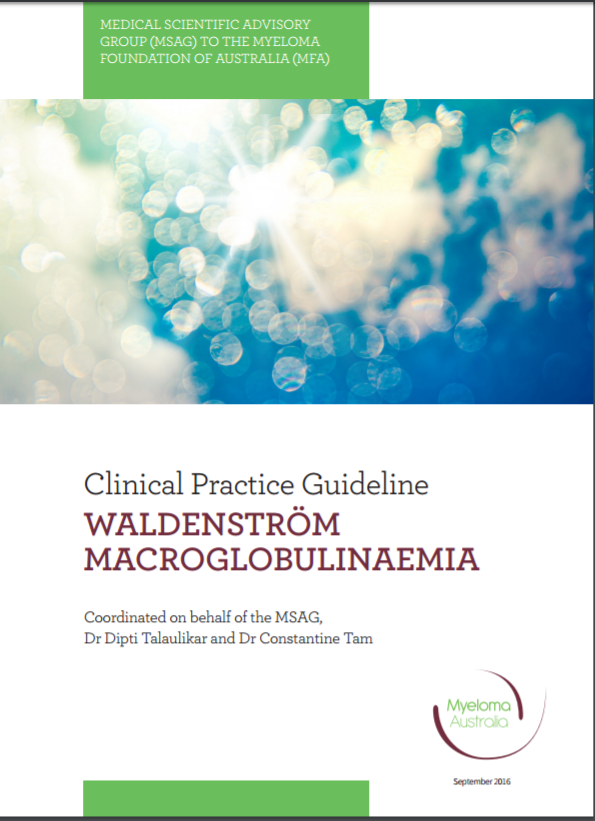Australian WM management guidelines
The clinical practice guideline for the treatment of Waldenström’s Macroglobulinemia (WM) has tables covering:
1. Level of evidence and grades of recommendations
2. Spectrum of IgM Gammopathy, and Treatment Indications
3. Recommended Workup for WM
4. Differential diagnosis of WM
5. International Workshop on Waldenström’s Macroglobulinemia (IWMM) response criteria
6. Doses and Schedules of Frontline Regimens for WM
A supplementary Table and Appendix cover:
· Overview of Published Regimens for the Treatment of WM
· International Consensus Statements on Treatment of WM (The major difference between the IWWM guidelines and Australian practice is the lack of public funding for bortezomib and ibrutinib for treatment of WM in Australia).
Boxes in the Guideline cover:
1. Workup of Suspected WM
2. Initial Therapy of WM
3. Treatment of Relapsed WM
Section 4.1.2 of the Guideline covers Drug access in Australia. Key points included are:
· An important practice point for Australian clinicians is the access to Pharmaceutical Benefits Scheme (PBS) subsidised drugs for the treatment of WM.
· Bendamustine has recently been approved on the PBS for first line treatment of indolent NHL (iNHL) but is not reimbursed for patients with relapsed or refractory disease.
· Clinicians should be aware of this limitation when planning a treatment strategy for patients with WM.
· Rituximab has been PBS listed for the relapsed or refractory setting and access has been recently expanded for CD20 positive low grade lymphomas in the frontline setting.
· Bortezomib and ibrutinib are not yet available on PBS for the treatment of WM
· Therefore, treatment recommendations in Australia differ from those of international guidelines with a reduced emphasis on bortezomib, ibrutinib and other newer agents.
· Although an adequately powered, randomised study of rituximab inclusion in frontline induction of WM is lacking, the collective favourable outcomes of rituximab in combination with chemotherapy in the treatment of other B-cell malignancies has led to its inclusion as frontline therapy in these guidelines (grade C recommendation, level III-3 evidence).
· Due to the relative paucity of randomised controlled trials in WM, it is strongly recommended that patients be enrolled in clinical trials – cross referrals to tertiary centres with trial availability should be considered.
The Guideline is a consensus established by the Australian Medical Scientific Advisory Group (MSAG) to the Myeloma Foundation Australia. MSAG consists of:
· A panel of 24 haematologists across Australia, as well as local experts.
· They represent 24 Australian organisations covering:
o University departments of haematology, clinical haematology and BMT
o Institute of medical research
o Faculties of medicine, health, nursing, medical & health sciences and
o Medical schools.
The equal contributor authors of the Guideline are Assoc Professor Dipti Talaulikar and Constantine S. Tam. All states and territories are represented by the 24 panel members. The panel includes seven members who are in IWMF Directory of Australian WM Doctors.





